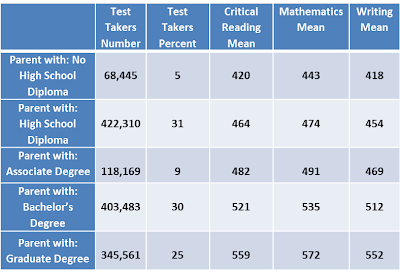How Prevalent is Family Education on the Impact of Student Achievement?
SAT
scores are reported on a scale from 200-800, with
additional sub scores reported for the essay (ranging from 2-12) and for
multiple-choice writing questions (on a 20-80 scale). The national average for
each section of the test is approximately 500.
The Factors
This post aims to analyze one of main components that inhibit
a successful learning environment. Studies show that student home life, family
education, family income, and the skewed education system all produce significant impacts on creating a quality academic experience.
Students from lower income families tend to have issues developing academically in comparison to students from high SES families. Many low SES families lack education themselves, therefore, do not encourage their children to receive a quality education. While this may not always be the case, there are many instances where education is not as important as putting food on the table.
Students from lower income families tend to have issues developing academically in comparison to students from high SES families. Many low SES families lack education themselves, therefore, do not encourage their children to receive a quality education. While this may not always be the case, there are many instances where education is not as important as putting food on the table.
This
determines that students with parents having no high school diploma have scores
much below the average. Students do not begin to fall into the average range
until they are under the categories where parents have some college education.
The Breakdown
This main aspects inhibiting student success in the classroom can be broken down according to the following:
The Breakdown
This main aspects inhibiting student success in the classroom can be broken down according to the following:
- School Sector
- Public or private school
- Class size
- High SES students= small classrooms, quality teacher/peer relationships
- Low SES students= large classrooms, no motivation for success
This is only one of the many issues that are responsible for creating the current educational gap. Please review other blog posts for further information on this issue.

No comments:
Post a Comment